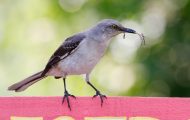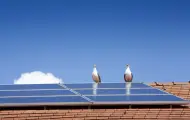Have you heard strange noises in your attic lately? Are you concerned that the birds in your attic may make you sick? It’s a common problem and one that’s hard to ignore.
To make matters worse, their presence often creates an unhealthy environment in the house and invites other pests like ticks and fleas into your home. Birds living in an attic can have serious health implications for people living in the home, so it’s important to understand how these creatures can affect your health and what steps must be taken to resolve the issue.
Fortunately, there are ways to prevent and deal with a pesky avian infestation in the attic, from sealing off entry points to getting rid of nests and droppings safely.
In this article, we’ll explore how having birds in the attic can make you sick and what you can do about it.
Signs That You Have Birds in Your Attic
 Are you suspecting that birds might have entered your attic and taken up residence? If so, the telltale signs of birds in the attic can help confirm your suspicions. Being aware of these signs will make it much easier for you to take the proper course of action if birds have indeed infiltrated your home.
Are you suspecting that birds might have entered your attic and taken up residence? If so, the telltale signs of birds in the attic can help confirm your suspicions. Being aware of these signs will make it much easier for you to take the proper course of action if birds have indeed infiltrated your home.
🏚 You Hear Sounds
If you hear a random bird chirping coming from your attic, it is a sign that you have birds in there. This particular sound may give away their presence more significantly than scratching and scuffling.
There could be multiple birds in the attic, so the sound can either be quite loud or faint, depending on the space the birds occupy. Other than chirping, you could hear scraping and rustling as well. I
t’s usually a pretty distinctive noise, and if you’re familiar with what a certain type of bird sounds like, you may even be able to identify that species in particular. If the activity near your attic is continuous throughout the day and night, it is an even stronger indication of an avian infestation.
🏚 Respiratory Problems
Another sign that birds may have taken up residence in your attic involves respiratory problems. It’s not uncommon to experience breathing issues when birds are present in your home or even on the premises due to the vast accumulation of bird droppings, feathers, and nests in your attic.
In many cases, these can cause serious respiratory issues such as asthma and allergies, leading to sneezing, coughing, and long-term health risks.
Furthermore, some people may experience headaches and itching eyes when exposed to feather dust in bird droppings. If you start to notice any of these symptoms without a clear source, birds may have taken refuge in your attic and contaminated the air with airborne pathogens and other allergens.
🏚 Holes in the Roof
If you suspect that these flying guests have made themselves at home, one of the biggest signs is some holes appearing in your roof. The entrance will likely be located near a chimney or along the edge of the eaves.
It’s possible to see where they’ve been pecking at from outside, so check there first! These holes make your exterior look terrible. Plus, it can lead to further problems like water seeping through or heat escaping from indoors.
Ironically, most birds are very good at finding weak points around the roofing material, leading to even more damage. If you think birds may have settled down above your head, take a quick look outside for some telltale hole patterns and take steps to move them on accordingly.
🏚 Concentrated Droppings
These droppings will indicate if you start to notice a large accumulation of whitish-gray pellets around your gutters, air vents, and windowsills. If you look up, it will become evident that a lot of these excrements are coming from the highest parts of your home, usually near the peak or angles of the roof – which further confirms the idea that birds are likely residing in your attic.
Because birds rely on insects for their diet, you could find evidence suggesting a bird infestation depends on what type of bugs are attracted to the area due to their presence. Along with this, there is usually an odor associated with bird droppings and discolored patching around where they have been present. Therefore, be sure to pay attention to anything out of the ordinary if you fear a potential invasion.
🏚 Debris
Feather clusters and other remnants are often telltale signs that our feathered friends have taken up residence in our homes. Moreover, roosting birds or their nest materials may have blocked attic vents or exhaust fans. Nesting materials such as twigs, straws, and leaves will likely be found scattered beneath the entry area.
🏚 Damaged Gardens
The damage caused to your garden can range from mild annoyance to a full-scale disaster. In some cases, birds may consume almost all of a garden’s harvest, resulting in economic loss.
Fruits and vegetables can also be visibly damaged, with unsightly holes chewed into them or broken off completely due to the birds’ sharp beaks and claws. Compromised soil health is another problem associated with these feathered intruders because of their digging habits.
5 Most Common Birds Found in Attics
There are a number of birds that may choose to take residence in an attic. Here are the five most common offenders:
① Pigeon
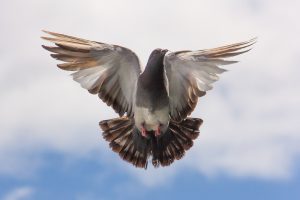 Pigeons are among the most common birds found in attics. They are known for their cooing sounds and small body size. Pigeons can nest anywhere, including in your attic. They build their nests in hidden, sheltered places, such as the corners of your roof or the nooks and crannies of your attic.
Pigeons are among the most common birds found in attics. They are known for their cooing sounds and small body size. Pigeons can nest anywhere, including in your attic. They build their nests in hidden, sheltered places, such as the corners of your roof or the nooks and crannies of your attic.
② House Sparrow
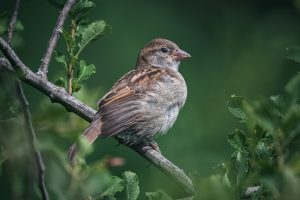 Sparrows are small birds that love to build nests in tight spaces. They often build their nests in the eaves of your home or inside attics. Sparrows are known for their distinctive chirping sounds and their small, vibrant bodies. Once they’re in your attic, they can be difficult to remove.
Sparrows are small birds that love to build nests in tight spaces. They often build their nests in the eaves of your home or inside attics. Sparrows are known for their distinctive chirping sounds and their small, vibrant bodies. Once they’re in your attic, they can be difficult to remove.
③ Starling
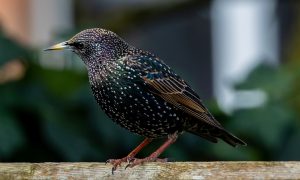 Starlings are medium-sized birds with dark feathers and sharp beaks. They are known for their vocalizations, ranging from whistles to screeches. Starlings are notorious for nesting in the eaves of homes, as well as inside attics. They are highly social birds, which means they may attract many other starlings to your home.
Starlings are medium-sized birds with dark feathers and sharp beaks. They are known for their vocalizations, ranging from whistles to screeches. Starlings are notorious for nesting in the eaves of homes, as well as inside attics. They are highly social birds, which means they may attract many other starlings to your home.
④ Swallows
 Swallows are small, agile birds that are known for their incredible flying abilities. They are commonly found in rural areas, especially near bodies of water. However, they can also find their way into attics if they search for a good nesting spot. Swallows build small, cup-shaped nests that are often hidden behind insulation or inside other nooks and crannies.
Swallows are small, agile birds that are known for their incredible flying abilities. They are commonly found in rural areas, especially near bodies of water. However, they can also find their way into attics if they search for a good nesting spot. Swallows build small, cup-shaped nests that are often hidden behind insulation or inside other nooks and crannies.
⑤ Woodpeckers
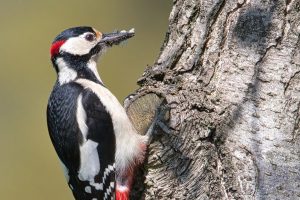 Woodpeckers are medium-sized birds with distinctive markings and powerful beaks. They are known for pecking at trees and other objects in search of food. However, they can also find their way into attics if they search for a good nesting spot. Woodpeckers build their nests by excavating holes in wood. They may use your attic’s rafters and other wooden structures as suitable nesting grounds.
Woodpeckers are medium-sized birds with distinctive markings and powerful beaks. They are known for pecking at trees and other objects in search of food. However, they can also find their way into attics if they search for a good nesting spot. Woodpeckers build their nests by excavating holes in wood. They may use your attic’s rafters and other wooden structures as suitable nesting grounds.
Can Birds In Your Attic Make You Sick?
 Birds are some of the most beautiful creatures in the world. They are fascinating to watch and listen to and bring joy and wonder to our lives. But have you ever thought about what happens when birds enter your attic? Many people assume it’s harmless, but the truth may surprise you. In fact, birds in your attic can actually make you sick!
Birds are some of the most beautiful creatures in the world. They are fascinating to watch and listen to and bring joy and wonder to our lives. But have you ever thought about what happens when birds enter your attic? Many people assume it’s harmless, but the truth may surprise you. In fact, birds in your attic can actually make you sick!
One of the ways that birds can make you sick is by carrying diseases. Birds can carry a variety of diseases that are harmful to humans. The most common disease that birds carry is called histoplasmosis. This disease is caused by a fungus that grows in bird droppings. When you breathe in the fungus, it can cause flu-like symptoms such as fever, cough, and fatigue.
Another disease that birds can carry is called psittacosis. This disease is caused by bacteria found in bird droppings and can cause pneumonia-like symptoms such as cough and fever. Other diseases that birds can carry include salmonella, E. coli, and West Nile virus.
Now, you might be thinking that these diseases are rare and that the chances of getting sick from birds in your attic are slim. However, the truth is that bird droppings can accumulate quickly and create a hazardous environment. Also, if you have a weakened immune system or suffer from respiratory problems, you are even more susceptible to catching these diseases.
Other Problems That Birds Can Cause
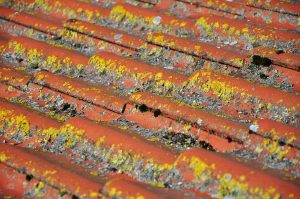 Aside from being a health hazard, birds in your attic can also cause other problems. Therefore, it is important to be aware of the potential problems that birds can create.
Aside from being a health hazard, birds in your attic can also cause other problems. Therefore, it is important to be aware of the potential problems that birds can create.
🏡 Corrosion
Contrary to popular belief, birds can do more damage than just making a mess. In fact, they can cause corrosion on surfaces like buildings and vehicles. When combined with oxygen and water from environmental elements like rain and humidity, bird droppings contain chemical substances that can weaken certain materials over time.
The corrosive effects can affect both aesthetics and structure of sites, depending on the environment in which it resides. In some cases, the corroded surface will need to be replaced entirely due to the extent of the corrosion that has occurred.
🏡 Condensation and Fire Hazard
Another common potential problem is the condensation they can cause in ventilation ducts, allowing water pooled on hard surfaces to drip and damage nearby electronics or documents kept inside.
Even more alarming, if flammable materials are in contact with droplets of liquid, there could be an increased risk of fire hazard due to the buildup of static electricity caused by wings flapping near the source of dampness. Homeowners need to take active steps to ensure these risks are monitored and mitigated lest disaster strikes!
🏡 Damaged Gutters
Gutters are essential in keeping a home’s exterior looking and functioning properly. But unfortunately, they can become clogged and damaged by various things – such as nesting birds inside. Sure, birds can be great to look at when they fly around or sing their pretty songs. However, when it comes to gutters, they can cause a lot of trouble.
If left unchecked, the accumulation of debris from nesting birds overhead can lead to a corroded gutter system, resulting in costly repairs or even replacements. Bird droppings can also contribute to clogging up the gutter system. It raises the risk of overflowing water due to improper runoff during rain and other weather events.
🏡 Structural Damage
Bird-related structural damage is a serious and often costly issue for property owners, ranging from minor to severe. Birds can cause various issues regarding the structure of buildings and homes.
In some cases, standing water from bird droppings can lead to mold and mildew growth. It accelerates rotting wood or other organic material that is part of the property’s structure.
Furthermore, acidic deposits on windowsills and balconies may corrode metal materials and stain outside walls. However, the most notable type of structural damage caused by birds is the nesting process itself.
Whether it’s wasps creating mud nests under eaves or pigeons scratching away mortar between bricks to create a comfortable environment for their young, this can ruin the aesthetics and weaken essential components of the home’s structure, potentially leading to collapse if left unchecked.
Taking preventative measures to stop these issues from occurring in the first place should be a top priority for all property owners!
How To Remove Birds From Your Attic
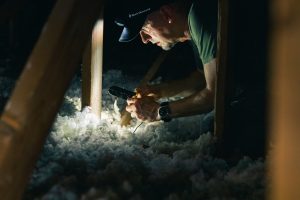 If you find yourself with birds in your attic, acting quickly is important. The longer the birds remain in your attic, the more likely they are to spread diseases and cause damage. Here are some tips on how to remove birds from your attic:
If you find yourself with birds in your attic, acting quickly is important. The longer the birds remain in your attic, the more likely they are to spread diseases and cause damage. Here are some tips on how to remove birds from your attic:
🕊 Use Humane Traps
Removing birds from your attic can be daunting, but it is more than possible with the right approach. To do so humanely, using traps is the best route. Start off by making sure that all potential hazards in the area have been removed or cordoned off, including any wires or sharp objects.
Humane traps should then be set up around entrance holes to the attic and baited with either sunflower seeds or other bird-friendly snacks. Keep an eye out for when the bird gets trapped. Then, check the trap every 8-12 hours under a towel. This will keep the bird calm and make it easier to transport outside.
Finally, release the bird away from your home. Make sure there are no cats or predators around which may attack it.
🕊 Set Up A Sound Emitter
Using a sound emitter can create an environment that the birds find uncomfortable, causing them to leave the area. And the best part is, sound emitters are totally human-safe! All you need to do is hang one up in your attic, and it will start sending out pressurized sonic waves at a specified frequency.
The loudness of the sounds shouldn’t affect humans because we can only hear from certain ranges. However, it will be enough for birds to feel intimidated and ultimately head somewhere safer.
It’s worth mentioning that this tactic won’t work instantly. Still, eventually, after multiple days of playing the same high-pitched noises, they’ll give up and go elsewhere – hopefully never coming back!
🕊 Seal Up Your Attic
Start by caulking around any openings. This could be vented, holes in the siding, or even small cracks in the windowsills. If possible, add new attic insulation to the walls and ceiling of your attic, as this will help prevent additional birds from coming inside.
To further protect against animals entering your home, install mesh netting around windows and other openings. This extra layer will keep animals out while allowing air circulation and light into the space. After completing these steps, make sure all systems are tested. Therefore, you know they are working properly before putting them in place.
🕊 Use Bird Gel
Bird Gel is a sticky, nontoxic gel applied to ledges and beams in your attic to discourage birds from perching or nesting. It has a light citrus scent, making it safer for both human and animal home residents.
The trick with Bird Gel is to use multiple applications around the region you’re trying to protect. Put it in spots where birds tend to hang out. Then, they will quickly realize they can no longer use your attic as their habitat.
Although Bird Gel won’t remove any nests or eggs that are already there, it will prevent them from returning or further nesting, allowing you time to address any existing dwellings safely. Although somewhat time-consuming, using Bird Gel is an easy and effective way to stop birds from invading your attic!
🕊 Place Reflective Items Around The Attic
This can be done in various ways; most commonly, you’ll want to hang shiny ribbons, strips of metallic tape, or similar objects from the rafters or ledges where birds are likely to perch. The reflection from the item is meant to scare away any unwanted visitors by reminding them that this territory is not theirs. In order to make sure the reflective items set up across your attic have the desired effect, it’s important to use different colors, shapes, and materials.
That way, you can maximize the variety of reflections that birds will encounter. Additionally, it’s important to regularly check the state of these items since they may eventually lose their shine and need replacing to ward off the birds effectively.
🕊 Set Up Decoys
Decoys come in a variety of shapes and sizes. For example, some common choices include wooden bird sculptures, plastic owls, colorful balloons tied to the eaves, or mannequins. All of these serve as convincing replicas of predators that will scare any birds away from nesting in the area. To use a decoy correctly, you should place it so that it’s visible from the direction birds would fly in. Make sure it is big enough to be seen from far away. It’s also important to move the decoy around occasionally so that the birds don’t become used to it and ignore it after a while.
Using decoys is usually an easy and affordable way to keep birds away and protect your home. It will provide peace of mind for years to come.
🕊 Call A Professional Wildlife Removal Services
Pest control experts are specially trained to deal with bird and animal infestations, so they can easily remove the bird safely and humanely without causing any harm. With specialized bird control products such as traps and baits, technicians can identify potential entry points and close them off to keep birds away for good. It’s an effective way to deter birds from ever returning, giving you much-needed peace of mind.
Plus, speaking with a professional about why the birds might have targeted your property in the first place is key for preventing another unwanted winged guest from entering your attic.
Investing in professional pest control services is often far more cost-effective than trying to do it yourself. Therefore, if you find yourself in the unfortunate situation of needing to remove a bird from your attic, just call a pro!
Frequently Asked Questions
Q: How does bird removal work?
Bird removal is important for homes, businesses, and other buildings. It is the humane process of removing disruptive or damaging birds to property. This service typically involves using bird netting, bird spikes, and trapping to eliminate any unwelcome feathered friends. During the process, experts identify what kind of birds need to be removed and which environment will be better suited for them. After identification, specialized tools such as vent screens, bird guards, and exclusion barriers are used to keep out new birds while also assisting with their relocation in a safe environment — away from the structure they had taken over. In extremely rare cases where trapping isn’t successful, bird-repellent products may be implemented.
Q: How can I remove bird feces safely?
Bird droppings can be dangerous and unsightly, so it’s important to handle them properly. The best way to remove bird droppings is with a combination of soap and water or a specialized cleaning product that contains an enzyme-based solution. Wearing protective equipment such as gloves, goggles, and masks is also highly recommended. If the droppings are on a hard surface, you can use a scraper to remove them before cleaning and sanitizing the area. If the droppings are in an enclosed space, such as an attic or basement, it’s best to consult a professional to help safely remove them.
Q: Can an infected bird spread diseases to humans?
Absolutely, an infected bird can spread diseases to humans. Many of these illnesses can cause various symptoms ranging from minor respiratory distress to sometimes more severe reactions. In particular, certain avian viruses, such as West Nile Virus, are usually transmitted through mosquitoes after they’ve bitten an infected bird. It can cause infections that lead to serious illnesses like brain inflammation. This virus isn’t unique, though. Other pathogens, such as Salmonella and MERS-CoV, are known to be spread by various types of birds. Thus, we all need to be aware of the potential risks associated with contact with these animals.
Q: When do I need to call a bird removal professional?
If you notice large numbers of birds gathering around your property or suspended nests on the exterior of your building, that’s usually a sign that it’s time to call for help. Bird droppings can carry health risks to humans. Hence, having an expert come in and assess the situation is always wise. Professional removal services can also provide continued bird control. In addition, they will offer preventative measures against any future bird issues you may experience. As soon as you suspect a problem, don’t hesitate to contact an experienced professional who can resolve it quickly and safely.
Q: Why is prevention important when it comes to bird removal?
Prevention is key when dealing with birds. Plus, being proactive can save you a lot of trouble and expense in the long run. Installing physical barriers such as bird spikes, netting, and screens are great ways to discourage birds from entering an area. You should also look into using repellents like sound machines or brightly colored flags. Finally, it’s important to ensure that birds’ food sources — including pet food, bird feeders, and trash — are stored securely so they’re not easily accessible by birds. Taking these precautions early on can help greatly reduce the chances of needing to call a bird removal professional.
Final Words
All in all, it’s safe to say that having birds in your attic can be a serious business. Not only are the droppings from these birds capable of causing structural damage to your home, but they may also contain parasites and fungi that can make you sick. It’s best to address avian infestations as soon as possible before any health risks or property damage can compound.

